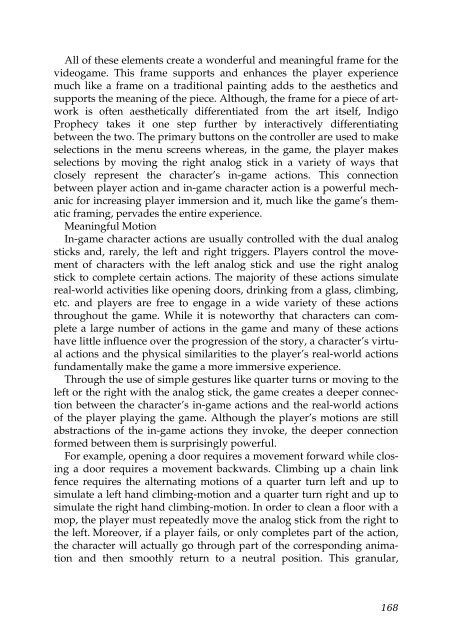Well Played 2.0: Video Games, Value and Meaning - OpenLibra
Well Played 2.0: Video Games, Value and Meaning - OpenLibra
Well Played 2.0: Video Games, Value and Meaning - OpenLibra
You also want an ePaper? Increase the reach of your titles
YUMPU automatically turns print PDFs into web optimized ePapers that Google loves.
All of these elements create a wonderful <strong>and</strong> meaningful frame for the<br />
videogame. This frame supports <strong>and</strong> enhances the player experience<br />
much like a frame on a traditional painting adds to the aesthetics <strong>and</strong><br />
supports the meaning of the piece. Although, the frame for a piece of artwork<br />
is often aesthetically differentiated from the art itself, Indigo<br />
Prophecy takes it one step further by interactively differentiating<br />
between the two. The primary buttons on the controller are used to make<br />
selections in the menu screens whereas, in the game, the player makes<br />
selections by moving the right analog stick in a variety of ways that<br />
closely represent the character’s in-game actions. This connection<br />
between player action <strong>and</strong> in-game character action is a powerful mechanic<br />
for increasing player immersion <strong>and</strong> it, much like the game’s thematic<br />
framing, pervades the entire experience.<br />
<strong>Meaning</strong>ful Motion<br />
In-game character actions are usually controlled with the dual analog<br />
sticks <strong>and</strong>, rarely, the left <strong>and</strong> right triggers. Players control the movement<br />
of characters with the left analog stick <strong>and</strong> use the right analog<br />
stick to complete certain actions. The majority of these actions simulate<br />
real-world activities like opening doors, drinking from a glass, climbing,<br />
etc. <strong>and</strong> players are free to engage in a wide variety of these actions<br />
throughout the game. While it is noteworthy that characters can complete<br />
a large number of actions in the game <strong>and</strong> many of these actions<br />
have little influence over the progression of the story, a character’s virtual<br />
actions <strong>and</strong> the physical similarities to the player’s real-world actions<br />
fundamentally make the game a more immersive experience.<br />
Through the use of simple gestures like quarter turns or moving to the<br />
left or the right with the analog stick, the game creates a deeper connection<br />
between the character’s in-game actions <strong>and</strong> the real-world actions<br />
of the player playing the game. Although the player’s motions are still<br />
abstractions of the in-game actions they invoke, the deeper connection<br />
formed between them is surprisingly powerful.<br />
For example, opening a door requires a movement forward while closing<br />
a door requires a movement backwards. Climbing up a chain link<br />
fence requires the alternating motions of a quarter turn left <strong>and</strong> up to<br />
simulate a left h<strong>and</strong> climbing-motion <strong>and</strong> a quarter turn right <strong>and</strong> up to<br />
simulate the right h<strong>and</strong> climbing-motion. In order to clean a floor with a<br />
mop, the player must repeatedly move the analog stick from the right to<br />
the left. Moreover, if a player fails, or only completes part of the action,<br />
the character will actually go through part of the corresponding animation<br />
<strong>and</strong> then smoothly return to a neutral position. This granular,<br />
168

















